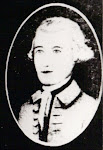Analysis of a Family Tradition:
The Richard Stanford “Silver Dollar” Story
by Terri Bradshaw O’Neill, 1999 ©
The story has been passed down in one branch of the family from the time of Mary Moore Stanford (1778-1851), daughter of Stephen Moore and wife of the Hon. Richard Stanford (1767-1816). Some of the salient points of the story are that Congressman Richard Stanford, having been elected to the first Congress, was Chairman of the Finance Committee and as a result, was instrumental in the design and first coining of the U. S. silver dollar, and determined the weight of the silver content by collecting specimens of the Spanish milled dollar in circulation from all thirteen colonies. He had them weighed and the average silver content was found to be 374 1/4 grains of silver and that is what he decided the weight of our silver dollars should be, though others argued that evening out the weight to 370 would simplify matters. The story continues to relate that, being a Quaker, Stanford’s principles caused him to declare, “Pay what thou owest”, and his estimation of the worth of the dollar prevailed.
The problems are in the time line.
· The First Congress was held in New York City in 1789.
· The Mint was established in Philadelphia in 1792. No silver dollars were struck until 1794.
· Richard Stanford was first elected to the House in 1797, and he took his seat in the Fifth Congress in May, 1797, at Philadelphia. While the Senate had what was called a Finance Committee, the House had a Ways and Means Committee. Richard Stanford’s name does not appear on that committee in the Annals of Congress. It seems unlikely that a freshman congressman would attain such a position.
In addition to the problems of the time line, there is the assertion that Richard Stanford was a Quaker. While he must surely have counted Quakers among his friends, acquaintances and constituents, it is not likely that he was a Quaker himself, for these reasons:
· Richard Stanford left many letters, some of which discussed his religious beliefs and even his doubts regarding religion
· It was the practice of Quakers to use the pronouns “thee” and “thou”; they also expressed dates by saying “the 4th day of the 3rd month...” rather than using the name of the months. Richard Stanford never did this.
· He was a slave owner
· He gave sworn testimony as a member of Congress, Quakers affirmed
· His will begins “In the name of God, Amen...”, a form not used by Quakers
I suspect that the story is apocryphal and was used to illustrate the fundamental integrity of our honorable forebear, Richard Stanford. If we consider the time and place that Congressman Stanford took his seat in the House of Representatives, and recall the names of his contemporaries and the leaders of government, we can begin to understand how such a family legend could have been polished and embellished over the ensuing generations. The mere mention of the names of Washington, Jefferson, Hamilton and so many others of the galaxy then assembled in Philadelphia in those early years of Richard Stanford’s career in the House, would have struck awe in his listeners. They must have been enthusiastically discussed and celebrated in every generation following him. Congressman Stanford’s tales of Philadelphia and Washington would have been told and retold with the pride of knowing that their father or grandfather had been there in those formative years. He had known, worked, socialized and had mutual interests with the most important and influential men of their time. He grew in experience and statesmanship and reputation in his own right. It was surely at the time of his first term of office in Philadelphia that Richard Stanford made the acquaintance of Dr. Benjamin Rush, from whom he later sought medical advice for his sister-in-law, Ann Moore. Dr. Rush was a Signer of the Declaration of Independence and had treated another member of the Moore clan in 1793. During Philadelphia’s Yellow Fever epidemic of that year, Dr. Rush treated Rebecca Moore Smith, daughter of William Moore and wife of Rev. William Smith, Provost of the College of Philadelphia. From 1797 until his death in 1813, Benjamin Rush was the treasurer of the U. S. Mint in Philadelphia. Is this obscure connection the grain of sand that became the pearl of family lore?
Wednesday, July 1, 2009
The Richard Stanford “Silver Dollar” Story
indexed:
Dr. Benjamin Rush,
Richard Stanford,
US Congress
Subscribe to:
Post Comments (Atom)









No comments:
Post a Comment